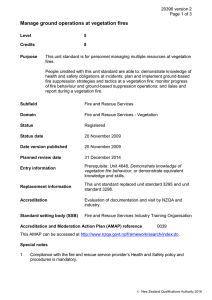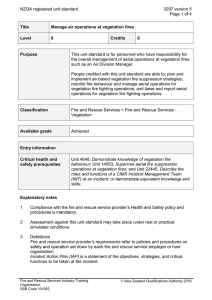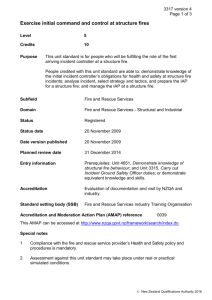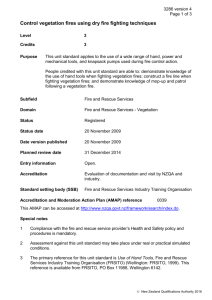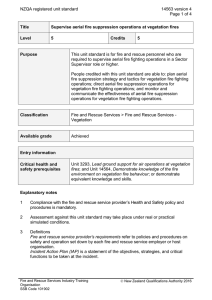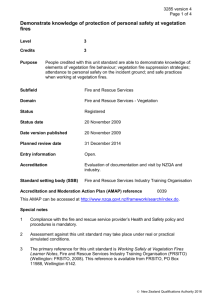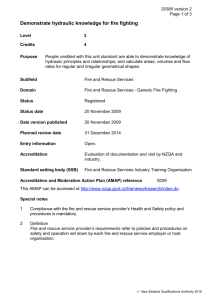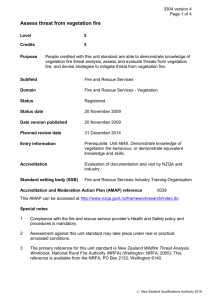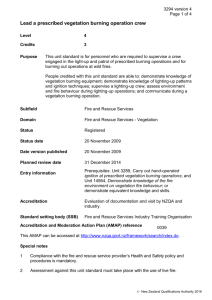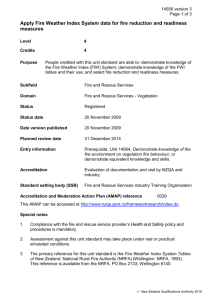3290 Exercise initial response, command, and control for
advertisement
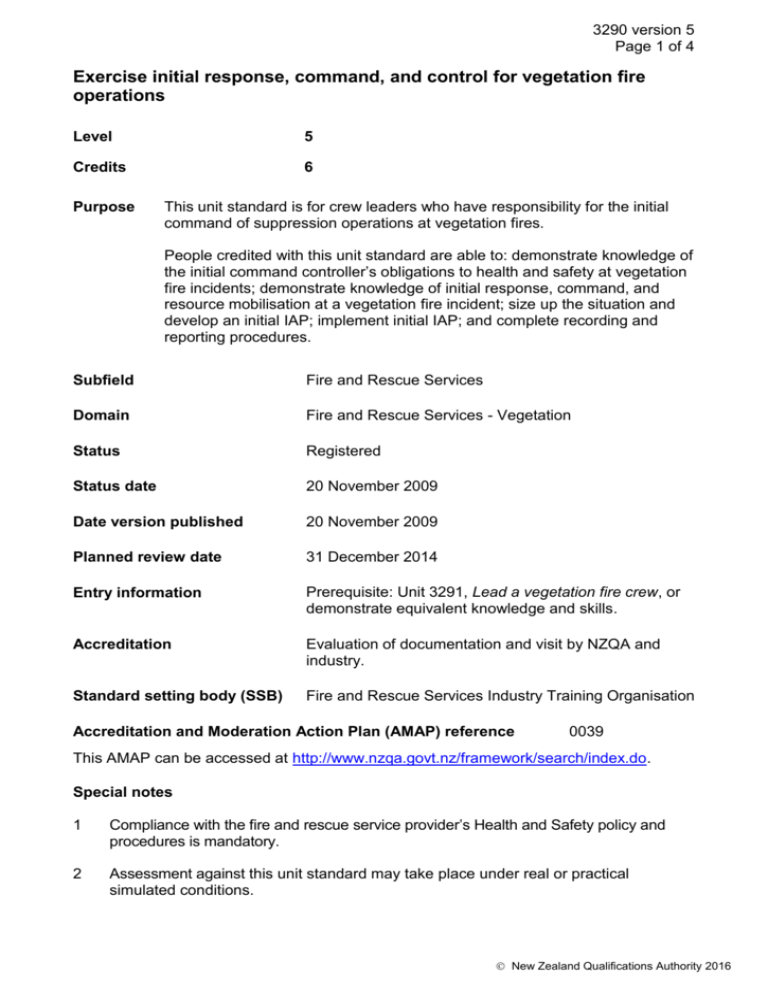
3290 version 5 Page 1 of 4 Exercise initial response, command, and control for vegetation fire operations Level 5 Credits 6 Purpose This unit standard is for crew leaders who have responsibility for the initial command of suppression operations at vegetation fires. People credited with this unit standard are able to: demonstrate knowledge of the initial command controller’s obligations to health and safety at vegetation fire incidents; demonstrate knowledge of initial response, command, and resource mobilisation at a vegetation fire incident; size up the situation and develop an initial IAP; implement initial IAP; and complete recording and reporting procedures. Subfield Fire and Rescue Services Domain Fire and Rescue Services - Vegetation Status Registered Status date 20 November 2009 Date version published 20 November 2009 Planned review date 31 December 2014 Entry information Prerequisite: Unit 3291, Lead a vegetation fire crew, or demonstrate equivalent knowledge and skills. Accreditation Evaluation of documentation and visit by NZQA and industry. Standard setting body (SSB) Fire and Rescue Services Industry Training Organisation Accreditation and Moderation Action Plan (AMAP) reference 0039 This AMAP can be accessed at http://www.nzqa.govt.nz/framework/search/index.do. Special notes 1 Compliance with the fire and rescue service provider’s Health and Safety policy and procedures is mandatory. 2 Assessment against this unit standard may take place under real or practical simulated conditions. New Zealand Qualifications Authority 2016 3290 version 5 Page 2 of 4 3 Legislation relevant to this unit standard includes the Forest and Rural Fires Act 1977, Forest and Rural Fires Regulations 2005, and Fire Service Act 1975. 4 The primary reference for this unit standard is Exercise initial response, command, and control for vegetation fire operations – Initial Attack Incident Controller Student Notes, National Rural Fire Authority (NRFA) (Wellington: NRFA, 2005). This reference is available from the NRFA, PO Box 2133, Wellington 6140. 5 Definitions Fire and rescue service provider’s requirements refer to policies and procedures on safety and operation set down by each fire and rescue service employer or host organisation. Incident Action Plan (IAP) is a statement of the objectives, strategies, and critical functions to be taken at the incident. Elements and performance criteria Element 1 Demonstrate knowledge of the initial command controller’s obligations to health and safety at vegetation fire incidents. Performance criteria 1.1 Principles of risk management are defined in accordance with the primary reference. 1.2 The allocation of tasks is explained with respect to personnel and equipment in accordance with the primary reference. 1.3 The process used to deal with identified hazards is explained in accordance with the fire and rescue service provider’s requirements. Element 2 Demonstrate knowledge of initial response, command, and resource mobilisation at a vegetation fire incident. Performance criteria 2.1 The powers and duties of the initial controller are explained in terms of the relevant legislation. 2.2 The information required upon initial activation is described in accordance with the primary reference. 2.3 The response and mobilisation requirements of the Fire Authority’s fire plan are explained in accordance with the fire and rescue service provider’s requirements. New Zealand Qualifications Authority 2016 3290 version 5 Page 3 of 4 Element 3 Size up the situation and develop an initial IAP. Performance criteria 3.1 The size-up and analysis of the situation are completed in accordance with the primary reference. Range 3.2 Develop an IAP for the situation in accordance with the fire and rescue service provider’s requirements. Range 3.3 organisation policy, fire environment, fire behaviour. Resources required to contain the fire are requested in accordance with the fire and rescue service provider’s requirements. Range 3.4 may include but is not limited to – extent of fire, hazards, resources, fire environment factors, assets at risk, time and distance considerations, communications, personnel safety requirements. resource – type, productivity. Factors that may alter the initial IAP are described in accordance with the fire and rescue service provider’s requirements. Element 4 Implement initial IAP. Performance criteria 4.1 The initial IAP is implemented in accordance with the fire and rescue service provider’s requirements. Range safety and operational briefing, allocation of tasks to crews, establishment of communications, deployment of resources, secure fire scene, preserve evidence. 4.2 Hazards are managed in accordance with the IAP. 4.3 The initial IAP is reviewed in response to the incident development in accordance with the fire and rescue service provider’s requirements. Range 4.4 resource availability, resource performance, fire behaviour. The fire is extinguished or control of the incident is handed over in accordance with the fire and rescue service provider’s requirements. New Zealand Qualifications Authority 2016 3290 version 5 Page 4 of 4 Element 5 Complete recording and reporting procedures. Performance criteria 5.1 Continuous logs are maintained and reporting is completed in accordance with the fire and rescue service provider’s requirements. Please note Providers must be accredited by NZQA, or an inter-institutional body with delegated authority for quality assurance, before they can report credits from assessment against unit standards or deliver courses of study leading to that assessment. Industry Training Organisations must be accredited by NZQA before they can register credits from assessment against unit standards. Accredited providers and Industry Training Organisations assessing against unit standards must engage with the moderation system that applies to those standards. Accreditation requirements and an outline of the moderation system that applies to this standard are outlined in the Accreditation and Moderation Action Plan (AMAP). The AMAP also includes useful information about special requirements for organisations wishing to develop education and training programmes, such as minimum qualifications for tutors and assessors, and special resource requirements. Comments on this unit standard Please contact the Fire and Rescue Services Industry Training Organisation info@frsito.org.nz if you wish to suggest changes to the content of this unit standard. New Zealand Qualifications Authority 2016
